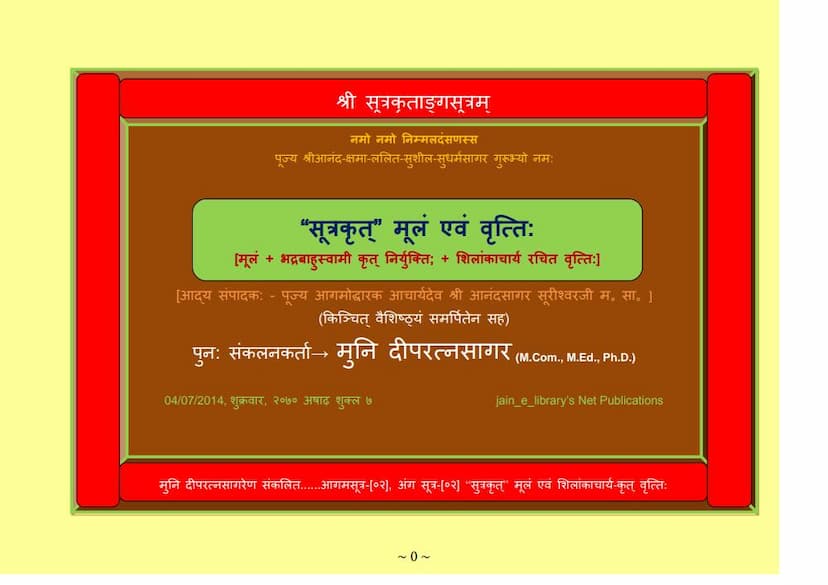Aagam 02 SOOTRAKUT Moolam Evam Vrutti
Added to library: September 1, 2025

Summary
This Jain text, titled "Aagam 02 SOOTRAKUT Moolam evam Vrutti," is a scholarly edition of the Sutrakrutanga Sutra, the second Anga (limb) of the Shrutaskandha (part of scriptural knowledge) in the Jain Agamas. Compiled by Muni Deepratnasagar, it includes the original Sanskrit/Prakrit text (Moolam), the Bhaavbahu Muni Krit Niyukti (commentary on the text), and the Shilankacharya Krit Vritti (detailed commentary).
The catalog link provided (https://jainqq.org/explore/004102/1) indicates it's a publication from Jain e library, suggesting a digital format with potentially extensive pagination. The provided pages cover the initial sections of the text, including:
-
Title Page and Acknowledgements (Pages 1-6): These pages introduce the book, its authors (Dipratnasagar, Deepratnasagar), publisher (Deepratnasagar), and highlight the editorial work done by Acharya Shri Anand Sagar Surishwarji Maharaj Saheb. There's also a discussion on the historical context of its publication and a comparison with other editions, emphasizing the value of the ancient tradition and the need for accessibility through digital means. The compilation by Muni Deepratnasagar is presented with specific formatting for ease of reading, including chapter, section, and verse numbering.
-
Introduction to the Sutrakrutanga Sutra (Pages 6-9): The text begins with the foundational elements of the Sutrakrutanga, including the salutation to Jain Tirthankaras and the purpose of the scripture. It delves into the meaning of the title "Sutrakrit," which refers to those who compose or elaborate upon the sutras. The concept of auspicious beginnings (Mangala) and the absence of explicit mangala in this text (as it's considered inherently auspicious) are discussed.
-
Nixepa (Categorization/Placement) (Pages 9-19): A significant portion of the introductory material focuses on the Nixepa concept, a fundamental Jain analytical tool. It explains how the term "Sutrakrit" itself is analyzed through various Nixepa categories (Nama, Sthapana, Dravya, Kshetra, Kala, Bhava), and similarly for the term "Karana" (action/instrument) which is a recurring theme in philosophical discussions. This section details the various types and sub-types of these Nixepa, illustrating the intricate analytical framework of Jain philosophy.
-
Subject Index (Pages 3-5): This provides a chapter-by-chapter overview of the contents of the Sutrakrutanga Sutra, detailing the various studies (Adhyayan) and sections (Uddeshak) within them. It lists topics such as:
- Shrutaskandha 1: Covering studies on the nature of time, self (Atma), different philosophical schools (Anekantavada, Karma Vada, Lokavada), the importance of non-violence (Ahimsa), the path to liberation (Mokshamarga), and descriptions of celestial gatherings (Samavasarana).
- Shrutaskandha 2: Discussing various practices and states of existence, including the nature of different bodies, karma, and spiritual practices.
-
Upaodghat (Prolegomenon/Introduction): The text begins with an extensive introduction that explains the structure of the Sutrakrutanga, its place within the Jain canon, and the methodologies employed in its analysis. It emphasizes the importance of understanding the correct meaning of the sutras and the various philosophical viewpoints that the Sutrakrutanga aims to refute or clarify.
Core Content of the Sutrakrutanga (as indicated by the index and initial content):
The Sutrakrutanga is known for its comprehensive refutation of various heterodox philosophical views prevalent during the time of Mahavira. It systematically analyzes and debunks theories related to:
- Causality and Action (Karma): Discussing theories of determinism (Niyati Vada), chance, fate, and various notions of karma and its role in liberation or suffering.
- The Nature of the Soul (Jiva) and Matter (Pudgala): Elaborating on the Jain perspective of soul as distinct from matter and refuting materialistic or other non-Jain views.
- Philosophical Schools: Critiquing various contemporary Indian philosophical schools and their doctrines, including those related to:
- Materialism (Charvaka): Views denying the soul, afterlife, and karma.
- Eternalism and Nihilism: Discussing theories about the permanence or annihilation of the self and the world.
- Theories of God/Creator: Refuting the concept of a creator deity.
- Views on Liberation (Moksha): Critiquing paths to liberation that do not align with the Jain understanding of right faith, knowledge, and conduct.
- Ethics and Practices: Emphasizing the core Jain principles of non-violence (Ahimsa), non-attachment (Aparigraha), and self-control.
Overall Significance:
The Sutrakrutanga is a foundational text for understanding Jain ethical and philosophical teachings. It aims to guide the practitioner towards the correct understanding of reality (Tattva) and the path to liberation by clarifying misconceptions and refuting erroneous views. The detailed commentaries (Niyukti and Vritti) provided in this edition by Muni Deepratnasagar and Shilankacharya, respectively, offer in-depth analysis and context, making the text accessible to contemporary readers. The compilation by Muni Deepratnasagar is a valuable effort to preserve and disseminate this important Jain scripture.